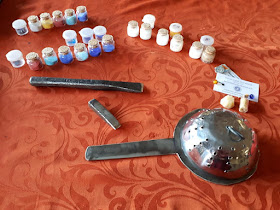 |
| Figure 1. Close up. |
On Sunday, August 4, 2019 I participated for the first time in the 22nd Annual Known World Arts & Sciences Display at Pennsic 48 with phase 1 of my Late Anglo-Saxon Enamel Brooch Project. From 1pm to 5pm I was one among a few dozen artisans displaying their projects from across the SCA Known World.
The 9 glass bottles on the right half of the display are of my White Paste experiments which I'll be writing a blog post about in the near future.
The colorfully filled glass bottles on the left half of the table are the enamels that I made from hand grinding several soft glass Lampworking rods of CoE 104 glass. [See Part 2, Part 3, and Part 4 of this blog series for more details.] The back row are the first 5 colors of glass rods that I ground. They were unfortunately contaminated from the marble mortar and pestle I used when I started this project. The front row of 6 enamels were entirely hand ground using a Stainless Steel mortar and pestle and fired beautifully as enamels. I switched to Stainless Stell once I read a passage from Cellini's Treatise in which he mentions using Steel, this made a great difference.
 |
| Figure 2. Full display. |
It was far too windy to put out either the small Sterling Silver bezels I enameled, the glass beads I set with White Paste in bezel settings, and sample pieces of the glass rods. I will need to attach them to a sturdy backing before St. Eligius Arts & Sciences Competition in mid November, hosted by the Barony of Dragonship Haven, so they can be seen without risking their loss to wind or by getting tipped over.
These are 3 of the 4 currently printed out binders of my research sources. I've found other papers that I need to print out.
The two cutting chisels and Muffle set were made by Doug Colin Guyton. The overall muffle design is based on my research of both Theophilus and Cellini's Treatises. The muffle top is also very similar to one of the extant finds of Georgian enameling muffle covers in the Georgian National Museum.
No comments:
Post a Comment